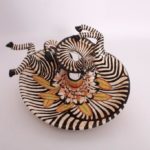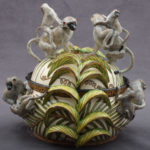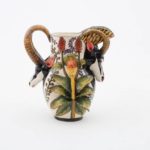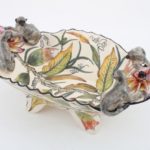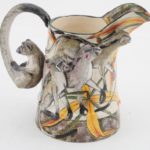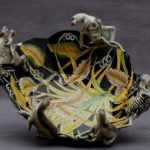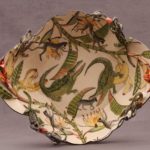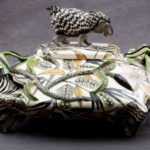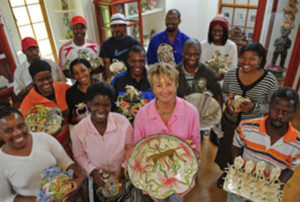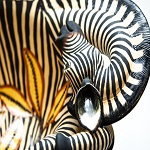Ardmore ceramics
Works
Bio
Ardmore Ceramic Art was established by Fée Halsted on Ardmore Farm in the foothills of the Drakensberg Mountains of KwaZulu-Natal, where she lived after obtaining her BA (Fine Arts) Honours degree and lecturing at Natal Technikon. Here she met Bonnie Ntshalintshali, daughter of their housekeeper, whose polio meant that she was unable to work in the fields. Fée and Bonnie quickly developed a synergy and under Fée’s mentorship, Bonnie’s natural skills as an artist blossomed. Five years later, in 1990, Fée and Bonnie were jointly awarded the prestigious Standard Bank Young Artist Award, the first such artistic partnership to be recognised. With this success came the demands of creating ceramics for their exhibition, so Fée offered other local women the opportunity to train at Ardmore, producing pieces to generate income for the fledgling studio.
Fèe, through necessity, developed the exuberant exotic style that has made Ardmore ceramics famous. “I made tiles and if one cracked, I’d stick a rabbit or bird on the top to hide it,” she recalls. Their work broke from the ceramic conventions of the time: fired terracotta clay was painted with plaka paints, boot polish and oven blackeners. Glues and putty were also used. Later American Amaco paints and transparent glazes brought vibrant colour and fine painting style to the ceramics.
In 1996, Fée and her family moved to Springvale Farm in Rosetta in the KZN Midlands, allowing the artists at the Berg Studio in the Champagne Valley to explore their independence. At Springvale she established a smaller studio and gallery, and in 2003, the Bonnie Ntshalintshali Museum was created to honour Fée’s co-artist and friend after her tragic death from HIV/AIDS in 1999.
A few years later, Fée and her family moved to the Caversham Valley, relocating the studio and museum and building a spacious gallery and offices. This created a unique home for Ardmore and in 2009 she amalgamated the Berg and Rosetta studios here.
Ardmore’s 25th anniversary in 2010 saw the launch of Ardmore Design Collection, which translated Ardmore’s distinctive imagery and styling into functional, superb quality ceramic and non-ceramic products including dinnerware, tapestries, furniture, fabrics for soft furnishings, and more. This new venture was made possible through a generous grant in late 2009 by the Business Trust’s Shared Growth Challenge Fund.
The artists from the Ardmore studio are given training, direction, materials, a studio and a guaranteed market for their work, supported by a skilled marketing and administrative team. Over the years, Ardmore’s artists have won numerous awards and exhibited widely in South Africa and around the world. Ardmore artworks feature in leading galleries and collections, including the Museum of Art & Design in New York and the Museum of Cultures in Basel, Switzerland.The acclaimed auction house Christie’s has acknowledged Ardmore artworks as “modern day collectibles”.



